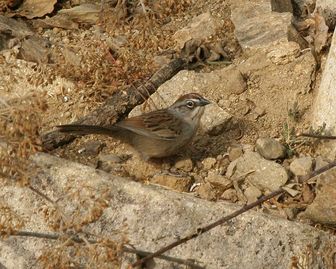Oaxaca Sparrow

Original source: dominic sheronyPermission(Reusing this file)This image, which was originally posted to Flickr.com, was uploaded to Commons using Flickr upload bot on 19:19, 26 September 2008 (UTC) by Sadalmelik (talk). On that date it was licensed under the license below. This file is licensed under the Creative Commons Attribution-Share Alike 2.0 Generic license.You are free:to share – to copy, distribute and transmit the work
Author: dominic sheronyPermission(Reusing this file)This image, which was originally posted to Flickr.com, was uploaded to Commons using Flickr upload bot on 19:19, 26 September 2008 (UTC) by Sadalmelik (talk). On that date it was licensed under the license below. This file is licensed under the Creative Commons Attribution-Share Alike 2.0 Generic license.You are free:to share – to copy, distribute and transmit the work
The Oaxaca Sparrow is classified as Near Threatened (NT), is close to qualifying for or is likely to qualify for a threatened category in the near future.
The Oaxaca Sparrow (Aimophila notosticta) is a species of bird in the Emberizidae family. It is endemic to the Mexican state of Oaxaca, where it lives in dry forests and thornscrub. It is threatened by habitat loss. References - * BirdLife International 2004. Aimophila notosticta. 2006 IUCN Red List of Threatened Species. Downloaded on 25 July 2007. More
"The Oaxaca Sparrow Aimophila-Notosticta has a chatter vocalization". Condor 82 (1): 111. doi:10.2307/1366802. * Hubbard JP (1975). "Geographic variation in non-California populations of the Rufous Crowned Sparrow". Nemouria 15: 1–28. * Morrison SA & Bolger DT (2002). "Lack of an urban edge effect on reproduction in a fragmentation-sensitive sparrow". Ecological Applications 12 (2): 398–411. doi:10.1890/1051-0761(2002)012. More
Oaxaca Sparrow and three endemic species of vireos: the Dwarf, Golden and Slaty Vireo. With luck, we may also find Ocellated Thrasher and Pileated Flycatcher. Nights in Oaxaca. Day 6 - Tehuantepec Today we make several stops along the drive to Tehuantepec, At the archaeological site of Yagul, surrounded by beautiful scenery, the endemic White-throated Towhee, Gray-breasted Woodpecker, Beautiful Hummingbird and Boucard’s Wren should not be difficult to find while, with luck, we may hope to see Bridled Sparrow. More
Slaty Vireos, Oaxaca Sparrow, White-throated Towhee) or in patches of desert scrub (Grey-breasted Woodpecker, Beautiful Hummingbird, Boucard`s Wren, Bridled Sparrow). To the north of the capital are mountains covered in oaks at mid-elevations and then in pine forests at the crest; logging roads on Cerro San Felipe provide access to fine habitat for Dwarf Jay (often with moving flocks of the canopy-dwelling Grey-barred Wren) and a good selection of Montane hummingbirds. More
Oaxaca Sparrow mere feet away as it fed on the open ground. This bird is usually quite hard to see in the winter, so we were quite lucky to see one first thing on the first day! We also saw White-throated Towhees in the undergrowth, but our attention was pulled away from them by large overflying flocks of clucking birds. Gray Silkies! We saw literally hundreds, including amazing scope views. About the same time, someone asked what the odd green bird with the blue and orange head was. More
Family : Emberizidae
Genus : Aimophila
Species : notosticta
Authority : (Sclater & Salvin, 1868)
